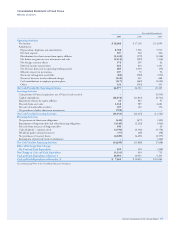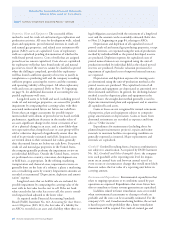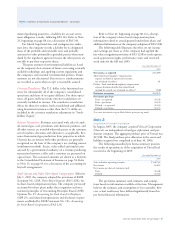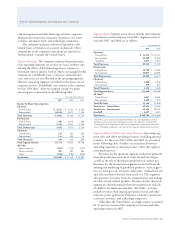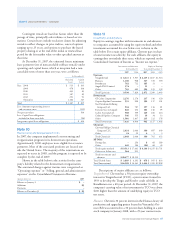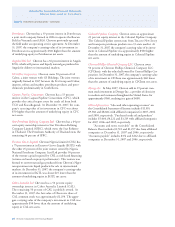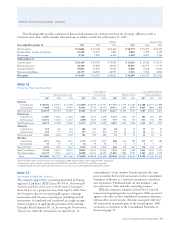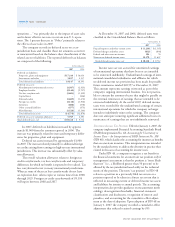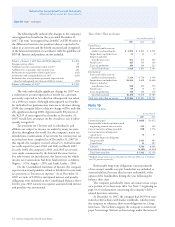Chevron 2007 Annual Report Download - page 66
Download and view the complete annual report
Please find page 66 of the 2007 Chevron annual report below. You can navigate through the pages in the report by either clicking on the pages listed below, or by using the keyword search tool below to find specific information within the annual report.
64
The trade receivable balances, reflecting the company’s
diver sified sources of revenue, are dispersed among the
company’s broad customer base worldwide. As a consequence,
the company believes concentrations of credit risk are limited.
The company routinely assesses the financial strength of its
customers. When the financial strength of a customer is not
considered sufficient, requiring Letters of Credit is a principal
method used to support sales to customers.
Although each subsidiary of Chevron is responsible for its
own affairs, Chevron Corporation manages its investments
in these subsidiaries and their affiliates. For this purpose,
the investments are grouped as follows: upstream – explora-
tion and production; downstream – refining, marketing and
transportation; chemicals; and all other. The first three of
these groupings represent the company’s “reportable segments”
and “operating segments” as defined in Financial Accounting
Standards Board (FASB) Statement No. 131, Disclosures About
Segments of an Enterprise and Related Information (FAS 131).
The segments are separately managed for investment
purposes under a structure that includes “segment managers”
who report to the company’s “chief operating decision maker”
(CODM) (terms as defined in FAS 131). The CODM is
the company’s Executive Committee, a committee of senior
officers that includes the Chief Executive Officer and that, in
turn, reports to the Board of Directors of Chevron Corporation.
The operating segments represent components of the
company as described in FAS 131 terms that engage in activi-
ties (a) from which revenues are earned and expenses are
incurred; (b) whose operating results are regularly reviewed
by the CODM, which makes decisions about resources to be
allocated to the segments and to assess their performance;
and (c) for which discrete financial information is available.
Segment managers for the reportable segments are
accountable directly to and maintain regular contact with the
company’s CODM to discuss the segment’s operating activities
and financial performance. The CODM approves annual
capital and exploratory budgets at the reportable segment level,
as well as reviews capital and exploratory funding for major
projects and approves major changes to the annual capital and
exploratory budgets. However, business-unit managers within
the operating segments are directly responsible for decisions
relating to project implementation and all other matters con-
nected with daily operations. Company officers who are
members of the Executive Committee also have individual
management responsibilities and participate in other commit-
tees for purposes other than acting as the CODM.
“All Other” activities include the company’s interest in
Dynegy (through May 2007, when Chevron sold its interest),
mining operations, power generation businesses, worldwide
The fair values of the outstanding contracts are reported
on the Consolidated Balance Sheet as “Accounts and notes
receivable” or “Accounts payable,” with gains and losses
reported as “Other income.”
Interest Rates The company enters into interest rate swaps as
part of its overall strategy to manage the interest rate risk on
its debt. Under the terms of the swaps, net cash settlements are
based on the difference between fixed-rate and floating-rate
interest amounts calculated by reference to agreed notional prin-
cipal amounts. Interest rate swaps related to a portion of the
company’s fixed-rate debt are accounted for as fair value hedges.
Fair values of the interest rate swaps are reported on the
Consolidated Balance Sheet as “Accounts and notes receiv-
able” or “Accounts payable.”
Fair Value Fair values are derived from quoted market prices,
other independent third-party quotes or, if not available, the
present value of the expected cash flows. The fair values reflect
the cash that would have been received or paid if the instru-
ments were settled at year-end.
Long-term debt of $2,132 and $5,131 had estimated
fair values of $2,325 and $5,621 at December 31, 2007 and
2006, respectively.
The company holds cash equivalents and marketable
securities in U.S. and non-U.S. portfolios. Eurodollar bonds,
floating-rate notes, time deposits and commercial paper are the
primary instruments held. Cash equivalents and marketable
securities had carrying/fair values of $5,427 and $9,200 at
Decem ber 31, 2007 and 2006, respectively. Of these balances,
$4,695 and $8,247 at the respective year-ends were classified as
cash equiv alents that had average maturities under 90 days.
The remainder, classified as marketable securities, had average
maturities of approximately one year. At December 31, 2007,
restricted cash with a carrying/fair value of $799 that is related
to capital-investment projects at the company’s Pascagoula,
Mississippi, refinery and Angola liquefied natural gas project
was reclassified from cash equivalents to a long-term deferred
asset on the Consolidated Balance Sheet. This restricted cash
was invested in short-term marketable securities.
Fair values of other financial and derivative instruments
at the end of 2007 and 2006 were not material.
Concentrations of Credit Risk The company’s financial instru-
ments that are exposed to concentrations of credit risk consist
primarily of its cash equivalents, marketable securities,
derivative financial instruments and trade receivables. The
company’s short-term investments are placed with a wide
array of financial institutions with high credit ratings. This
diversified investment policy limits the company’s exposure
both to credit risk and to concentrations of credit risk. Similar
standards of diversity and creditworthiness are applied to the
company’s counterparties in derivative instruments.
Notes to the Consolidated Financial Statements





